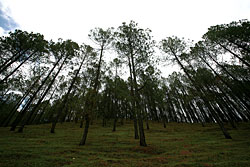 KIRAN PANDAY |
The question now is whether Nepal is eligible to reap rewards for its contribution to mitigating climate change.
Reducing Emissions from Deforestation and Forest Degradation (REDD) is the international mechanism through which countries that restore forests can be recognised and rewarded for greening their landscape. The scheme is also on the agenda of a big climate change conference in Copenhagen in December.
However, there is intense debate about which countries are eligible, what are the threshold levels of reforestation for qualification and what are the conditionalities.
]"We have a lot of work to do before the scheme is endorsed in Copenhagen," says Jagadish Chandra Baral of the Department of Soil Conservation and Watershed Management.
Thirty per cent of Nepal's land area is covered with forest or shrub, and 20 per cent is set aside as national parks. Community forests have expanded the canopy cover in the midhills, but forests have been decimated in the Tarai and the high mountains by crossborder timber smugglers and population pressure.
There are 14,300 community forestry user groups all over the country protecting 1.2 million hectares of forests: more than one-fourth of the total forest area. The community-protected forests sequester 188 million tons of carbon, according to a survey by the Livelihoods and Forestry Program.
The total amount of carbon offset that Nepal can realise from community forestry alone is between 1.8 to 3.6 million tons per year, and this means the country could earn anywhere up to $ 54 million a year in green brownie points from a future agreement coming out of the Copenhagen Summit.
However, we may be counting our chickens before they hatch. Nepal does get compensated about $ 600,000 a year for the carbon it doesn't pump into the atmosphere because of its successful biogas program. But there are still too many uncertainties about reducing emissions through forestry.
"To benefit, Nepal has to prepare measurable, reportable and verifiable reductions in emissions," explains Ugan Manandhar at the Worldwide Fund for Nature office in Kathmandu, "the mechanism will also need adequate and reliable funding starting immediately. Developed countries should commit to providing such funding in Copenhagen."
If Nepal gets this aid, it could set up a backbone for conservation, maintenance and management of its forests. The money will also be an encouragement to protect existing forests and for extending community forestry.
Experts say a lot will depend on how the compensation for mitigation is calculated, how the baseline is defined. Nepal's community forests aren't eligible for carbon credit under the present interpretation because they have a stock of only 1.8 tons per hectare per year, which falls below the threshold.
Says Baral: "We need to make alliances, negotiate skilfully if we want to get full credit for the carbon stock in our forests."
Countries like Nepal also need technical support to develop carbon inventory systems. There should be government bodies to regulate carbon financing, verifying, assessing and quantifying carbon stocks and offsets. There is also a question of who benefits from the credits.
Nepal has already got $200,000 from the World Bank's Forest Carbon Partner Facility for a Readiness Plan Idea Note and $ 3.4 million has been pledged to fund a Nepali carbon credit.
The government has also been too distracted with politics, so carbon credits and climate change is too far off in its time horizon. Said one official at the Ministry of Environment: "The coordination between the ministries is not a problem, politics is. Politicians go on junkets to summits, and there is no policy continuity."


